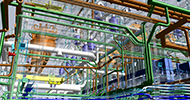From materials that fix themselves to swarm robots improving teamwork and generative design reshaping how we create, biomimicry is a fascinating source of inspiration and innovation. Read about three of the latest tech trends, inspired by nature, empowering the manufacturers of today and tomorrow.
Self-healing materials
Imagine you drop your mobile phone and the screen cracks. What do you do? Go to a repair shop? Buy a new one? How about waiting a few minutes and it’s fixed? That’s just one of the possibilities of a new branch of self-healing materials.
Living organisms have inspired many technological advances. From the design of wind turbine blades to the famous “hook and loop” structure of Velcro, biomimicry remains a fertile source of innovation. Cut your finger and a few days later it’s completely healed. What if machines had that ability?
Most materials decay over time, or through exposure to friction they wear out. These processes are gradual and easy to predict. It’s when materials fail suddenly or unexpectedly that the biggest problems occur. Spontaneous failure caused by internal flaws or a sudden impact can lead to disastrous consequences, especially in critical components. This is where the concept of self-healing materials can be game-changing.
A development at the University of Manchester
One of the latest and most exciting examples has been developed as recently as April 2024. In a recent blog post, the University of Manchester announced a fascinating breakthrough with the potential to revolutionise the field of self-healing materials. Researchers have developed a molecular device that:
“Under the influence of a mechanical force – such as that observed at an injured or damaged site – this component triggers the release of functional molecules, like medicines or healing agents, to precisely target the area in need.”
This particular study is so exciting because it overcomes the limitations of previous advances in this field by enabling the release of multiple healing agents at once. The team demonstrated the release of up to 5 different molecules, vastly improving the ability of self-healing materials to react to environmental damage.
The implications in manufacturing and product design are likely to be very important in the future. This kind of material innovation can extend the durability and lifecycle of the products we design and the machines we use to make them. This innovation could lead to products with a range of special capabilities, perhaps self-cleaning as well as self-healing. There is also a sustainability angle here. Since products could self-heal they could last longer and therefore have a lower carbon footprint.
A fascinating area for innovation and an exciting technology trend
The field of self-healing materials remains a fascinating area for innovation and an exciting technology trend to watch out for in the future. Design and discovery of innovative and self-sustainable materials is key to unlocking the full power of future materials and Hexagon Manufacturing Intelligence empowers its customers through the Digital Materials Suite. HxGN Digital Materials Suite enables the digital transformation of materials. These products also accelerate the Material selection process by complementing physical testing with multiscale material modelling and simulation.
This suite includes products like Digimat MS, that power multiscale simulations that enrich CAE analyses enabling engineers to design optimized components with best in class materials available without any compromise. Products like MaterialCenter and cloud native Materials Connect provide Material Data Management through access to leading commercial material databanks and high fidelity material cards from an established ecosystem of material suppliers. Materials Enrich empowers the customer to further extend their material database and explore new scenarios with material modelling and machine learning.
Swarm robotics
We’ve all heard of the wisdom of crowds, but what about the wisdom of crowds of insects? Swarm robotics is the term for a new form of automation based on the cooperative behaviour of insects.
One of the really fascinating things about swarm robotics is its decentralized approach to decision making. Instead of having a hierarchy, all the individual robots work together to accomplish their shared objectives. The decision making process is quite different to that of humans working in a team. Each robot follows a set of rules and behaviours that vary according to their local conditions – like the presence of another robot or an obstacle in its path.
With advances in AI, the individual robots in the group learn from their past experiences and improve the way they work over time. They share information about their environment, about the nature of their task or objects they need to maneuver. This makes swarm robots especially good for sorting, packaging, movement of goods, and even some assembly line processes where it offers incredible flexibility and customisation on previously rigid production line processes.
The decentralised approach offers a great deal more flexibility. If one individual breaks or malfunctions, the others simply step in and pick up the slack. The workload and the data is distributed evenly through the group. There is no single weak spot or point of failure.
A vital role in maintenance and inspection of automobiles
Swarm robotics is already finding a vital role in maintenance and inspection of automobiles. In 2018, Rolls Royce, in partnership with the Universities of Harvard and of Nottingham (UK), announced on their blog they were developing a type of automated inspection system that involved a set of collaborative, miniature robots, each around 10mm. These miniature robots would be programmed to move through the gaps and voids within the system inspecting all the internal structures. This gives engineers access and visibility to parts of their design that would normally be extremely difficult or even impossible to inspect without disassembly.
Swarm Robotics and evolution of other collaborative, distributed robotics ecosystem is an important pillar to the realisation of an autonomous manufacturing future. Autonomy in manufacturing will enable lights-out manufacturing helping manufacturers achieve efficiency, quality and productivity in the face of increasing skilled labour shortage and continued pressure on bottom line. Hexagon Manufacturing Intelligence is continuously working on innovations that empower such a future e.g. PRESTO System – an innovative modular suite of automated robotic inspection cells revolutionising the landscape of 3D measurement for automotive and aerospace manufacturing.
Generative design
Things in nature take form from millions of years of evolution. Natural processes inevitably find the most efficient way to achieve a goal. The course of a river through the landscape, the shape of a leaf, the fine structure of a bird’s wings, everything right up to the patterns of the universe and stars in the night sky are all examples of perfectly efficient natural designs. In a similar way, generative design explores a potentially infinite number of design possibilities to find the most efficient way to solve a problem.
When you look at a product made with a generative design approach, you see a form of biomimicry. The designs have an “organic” look about them that seems to mirror objects and shapes in the natural world.
Generative design creates optimised structures that bring together form and function in ways that a human designer would struggle to conceive. MSC Apex Generative Design from Hexagon bridges the gap between design and manufacturing by automatically creating feasible lightweight geometries that are optimised for additive manufacturing.
Traditional product design is a linear process. It follows a sequence from defining and researching a problem through to producing and evaluating different prototypes. It’s time consuming and it relies on the expertise, experience and knowledge of a product designer.
No preconceived notions, no bias…
Generative design is different. It has no preconceived notions, no bias, it’s not looking at a problem through a human lens. Instead, the designer inputs a series of requirements and limitations, such as the key dimensions, budget constraints, the required strength and durability of the final product. From there, the generative design software does the heavy lifting. With MSC Apex Generative Design, the user needs only to define the objectives, criteria, and constraints within the design space the user wishes to explore. It generates a potentially infinite number of iterations covering every conceivable variation. Then it tests them against the parameters set by the designer.
MSC Apex Generative Design makes it possible to design the costs of a part. Designs are no longer solely focused on the manufacturability but function‑oriented and purpose driven. Through lightweight design material within production can be saved, reducing time and costs of the print. The lower weight can help save resources within operation.
The results are often unconventional because ‘convention’ is a human characteristic.
One of the most exciting ways that generative design promises to revolution product design is in terms of sustainability. Generative design creates designs that use the least amount of material possible to meet the the brief. By producing lighter and more efficient designs, a generative approach improves energy efficiency. It reduces the carbon footprint of a product. It can also extend a product’s lifecycle. This promotes the shift towards a circular economy by designing for ease of recycling or end-of-life management.
Now we want to hear from you. Do you agree with us? What are the latest tech trends we didn’t mention? Share this blog with your networks and let’s continue the conversation online.
















